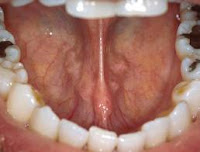Before we are born, a strong cord of tissue that guides development of mouth structures is positioned in the center of the mouth. It is called a frenulum or frenum. After birth, the lingual frenulum continues to guide the position of incoming teeth. As we grow, it recedes and thins. This frenulum is visible and easily felt if you look in the mirror under your tongue. In some children, the frenulum is especially tight or fails to recede and may cause tongue mobility problems.
The tongue is one of the most important muscles for speech and swallowing. For this reason having tongue-tie can lead to eating or speech problems, which may be serious in some individuals.
A new baby with a too tight frenulum can have trouble sucking and may have poor weight gain. While the tongue is remarkably able to compensate and many children have no speech impediments due to tongue-tie, others do. The following associated characteristics are common:
- V-shaped notch at the tip of the tongue
- Inability to stick out the tongue past the upper gums
- Inability to touch the roof of the mouth
- Difficulty moving the tongue from side to side
Tongue-tie surgery is a simple procedure and there are normally no complications. In most cases the procedure can be done without anesthesia when using a diode laser. This eliminates the need for incisions or stitches and has a faster comfortable healing for the patient. While frenulectomy is relatively simple, it can yield big results. Parents should consider that this surgery often yields more benefit than is obvious by restoring ease of speech and self-esteem.
For other dental information visit DrTav.com


No comments:
Post a Comment